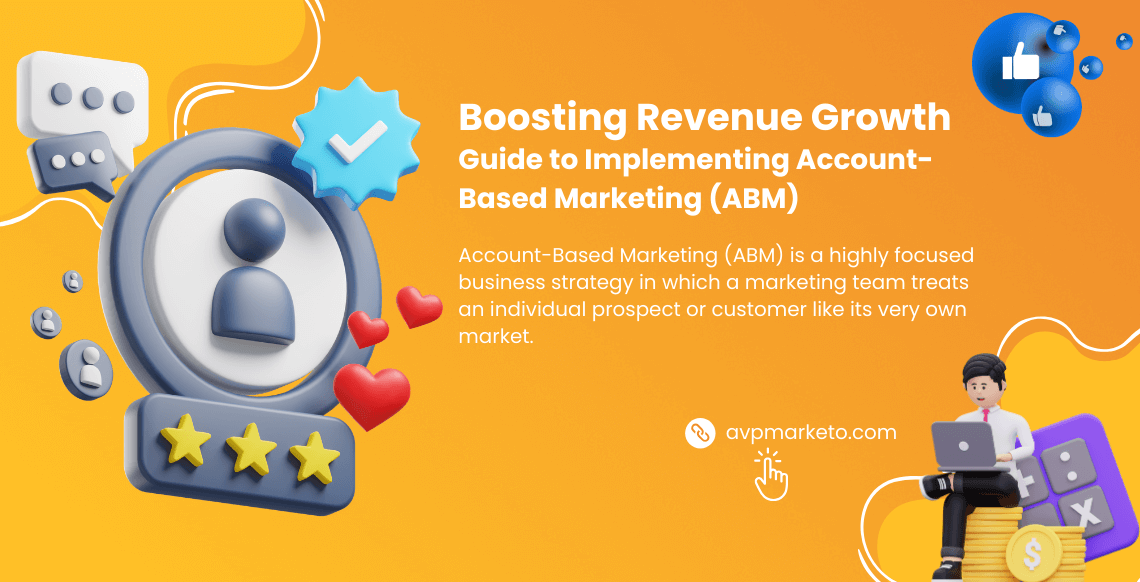Introduction: A Personal Anecdote
A few years ago, I worked with a mid-sized tech company struggling to align their marketing and sales teams. They were casting a wide net, hoping to catch any fish they could, but the results were lackluster. Then, they decided to pivot to Account-Based Marketing (ABM). Fast forward six months, and they were celebrating their best quarter ever, with a significant boost in revenue and much happier sales and marketing teams. This transformation was nothing short of remarkable.
This anecdote highlights the power of ABM in driving revenue growth. As we delve into the intricacies of ABM, you’ll discover how this targeted approach can revolutionize your marketing efforts, aligning them more closely with your sales goals to drive significant business growth.
Understanding Account-Based Marketing (ABM)
Definition and Key Concepts
Account-Based Marketing (ABM) is a highly focused business strategy in which a marketing team treats an individual prospect or customer like its very own market. Unlike traditional marketing approaches that cast a wide net, ABM focuses on key accounts—targeting specific organizations that are likely to yield the highest return. This strategy aligns marketing and sales efforts to create personalized buying experiences for high-value accounts.
Benefits of ABM
ABM offers several compelling benefits:
Higher ROI: By focusing resources on high-value accounts, ABM often yields a higher return on investment.
Personalized Marketing: Tailored campaigns resonate more with the target audience, increasing engagement and conversion rates.
Sales and Marketing Alignment: ABM fosters closer collaboration between sales and marketing teams, aligning efforts towards common goals.
For instance, one of our clients, a SaaS company, saw a 35% increase in their conversion rate within just three months of implementing an ABM strategy. The focused, personalized approach was a game-changer.
Preparing for ABM Implementation
Setting Clear Objectives
The first step in implementing ABM is setting clear, measurable objectives. What do you want to achieve? Increased revenue, higher engagement, or perhaps shorter sales cycles? Clear goals help in defining the strategy and measuring success. Aim for SMART goals—Specific, Measurable, Achievable, Relevant, and Time-bound.
Identifying Target Accounts
Selecting the right accounts is critical. Focus on high-value accounts that align with your business goals. Criteria for choosing these accounts may include revenue potential, strategic fit, and likelihood of conversion. Use data analytics to identify and prioritize these accounts based on historical data and predictive analytics.
Building Cross-Functional Teams
ABM requires a collaborative effort. Building a cross-functional team that includes members from sales, marketing, and other relevant departments is essential. Define roles and responsibilities clearly to ensure everyone is on the same page and working towards the same objectives.
Developing and Executing ABM Strategies
Personalized Marketing Campaigns
ABM thrives on personalization. Create highly targeted marketing campaigns for each account. This involves understanding the unique needs and pain points of each account and crafting messages that resonate. Personalization could be as simple as addressing the recipient by name or as complex as tailoring the entire marketing message to the specific challenges faced by the account.
Multi-Channel Engagement
Engage your target accounts across multiple channels to create a cohesive experience. This could include emails, social media interactions, direct mail, and even personalized events. Integrating various channels ensures that your message is consistently delivered, no matter where the target account engages with your brand.
Leveraging Technology and Data
Technology and data are the backbone of successful ABM strategies. Utilize tools and platforms for account selection, campaign management, and performance tracking. Data analytics can provide insights into account behavior, helping you refine and optimize your strategies continually.
Measuring and Optimizing ABM Performance
Key Metrics and KPIs
To gauge the success of your ABM efforts, focus on key metrics such as account engagement, pipeline growth, and revenue impact. Tracking these metrics helps in understanding what’s working and what’s not, allowing for informed adjustments to your strategy.
Continuous Improvement
ABM is not a set-it-and-forget-it strategy. Regularly review and optimize your approaches based on performance data. Conduct A/B tests, gather feedback, and make data-driven adjustments to continuously improve your ABM initiatives.
Conclusion: Your Path to Revenue Growth
Implementing a robust ABM strategy can transform your marketing efforts, driving significant revenue growth and enhancing the collaboration between your sales and marketing teams. By focusing on high-value accounts and delivering personalized experiences, you can achieve higher engagement and conversion rates.
Ready to boost your revenue growth with ABM? At AVP Marketo, we specialize in crafting and executing tailored ABM strategies that align with your business goals. Contact us today to schedule a consultation and discover how we can support your growth journey.


